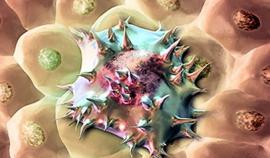Types of cancers of female genital mutilation
Cervical cancer occurs most often in women over 45 years old. The disease often occurs due to various ailments (dysplasia, erosions, polyps), important role played also formation of scars after childbirth and abortion. In the initial stages of the disease has virtually no symptoms, you can the first to find by contact bleeding (after douching, sexual intercourse or constipation). Such bleeding is cause for immediate referral to a specialist.
Uterine body cancer is more characteristic of women 50-60 years old. It is characterized by bleeding from the vagina or between menstrual periods or after menopause. If the process has come far, there are later signs of cancer: pain, leucorrhea.
Ovarian cancer is characteristic for all age groups, but it is more common after age 40. It is the most common oncological disease of female genital mutilation after cervical cancer. Risk Factors: transferred gynecological diseases, ovarian dysfunction, chronic inflammation, lack of sexual activity or pregnancy. Symptoms may be different, the earliest - lower abdominal pain, general fatigue, malaise, weakness.
Cancer of the uterine tube serves as a rare disease characteristic for older women. Main symptoms: lower abdominal pain, liquid discharge, with admixture of blood and pus.
Cancer of the vagina is also quite rare. Its symptoms: leucorrhea, pain, bleeding. If you put pressure on the tumor, occurs bleeding.
Cancer external organs occurs too rare and often combined with other long-lasting skin disease of genitals. It is characterized by the formation of dense node and growths.
Reasons for the development malignant diseases
- Various inflammatory processes,
- Diseases, sexually transmitted,
- Injury during childbirth and abortion,
- Failures in the endocrine system,
- Age-related changes,
- Exposure to radiation,
- Bad habits,
- A genetic mutation, that passed on from generation to generation.
Symptoms oncological diseases in Gynecology
- Allocation of different character from the genital tract - they arise regardless of the phase of the menstrual cycle, may be fetid, bloody, purulent or mucous.
- Changes in menstruation - elongation, profusely, pain. Often there may be the big bleeding, for a control over which the woman is placed in the hospital sick.
- Feeling neoplasm or discomfort from pressure them to other organs - is characteristic for the sufficiently developed process.
- Infertility - most often manifests itself as swelling of the ovaries, because It is this organ is the source of ovules.
- Pain in the genital area and increase the inguinal lymph nodes.
Methods of treatment in Oncology:
- Surgical intervention (removal of the tumor);
- Irradiation by radiation (radioactive effect on tumor);
- Hormone therapy (entering of hormones into the body, in the case of presence hormone-dependent and hormonally sensitive tumors);
- Chemotherapy (entered in the patient's body of toxic substances that suppress the development of tumors);
- Immunotherapy (stimulation of the patient's immune system to the emergence and development of tumors);
- Photodynamic therapy (the use of light-sensitive substances - photosensitizers);
- Virotherapy (artificial infection of the patient with the oncolytic viruses).
It is important to remember that oncological diseases lend themselves a more effective treatment in the early stages of development. Therefore, the best prevention from appearance of tumors - is a regular examination by a gynecologist for the timely diagnosis and treatment in case of illness.
hide
 Gynecological Oncology includes all types of tumors and cancer diseases of female genital mutilation. These include breast cancer, cervical cancer and cancer of the uterus (endometrial cancer) and ovarian cancer. At the same time the most common cancer diseases in women is breast cancer.
Gynecological Oncology includes all types of tumors and cancer diseases of female genital mutilation. These include breast cancer, cervical cancer and cancer of the uterus (endometrial cancer) and ovarian cancer. At the same time the most common cancer diseases in women is breast cancer. 






